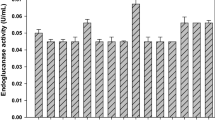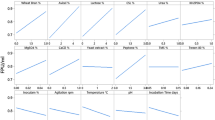Abstract
Cellulases are a complex of enzymes necessary for the complete solubilization of cellulose in sugars, thus playing a key role in the natural carbon cycle through the hydrolysis of lignocellulosic structures. The aim of this study was to evaluate the increase in the capacity of Talaromyces amestolkiae CMIAT 055 to produce cellulases by optimizing the components of the culture medium containing banana pseudostem as an inducer, as well as in different agitation configurations in a bioreactor. Optimization was performed through statistical experimental design (Plackett–Burman and DCCR), a study of pH control in bioreactors, and a study of the agitation system by comparing impellers with different flow profiles in the liquid medium. For this purpose, a wild strain of Talaromyces amestolkiae CMIAT 055 was used. In the Plackett–Burman and DCCR statistical design, four components of the culture medium were significant and optimized for greater synthesis of FPase: banana pseudostem, CaCl2, KH2PO4, and urea. In bioreactors tests, these parameters were beneficial for greater enzyme activities: maintenance of pH at 5.0, use of Pitched blade impeller, and rotation speed at 300 rpm. Comparing the first test using banana pseudostem in an Erlenmeyer flask to the last fermentation process in bioreactors, it was observed that the total cellulase activity increased from 424.7 to 2172.8 FPU/L. This fact showed that the strategies adopted in this study are a pertinent way to reduce the cost of enzyme production through the use of lignocellulosic materials.
Graphical Abstract







Similar content being viewed by others
Data Availability
Enquiries about data availability should be directed to the authors.
References
Juturu, V., Wu, J.C.: Microbial cellulases: engineering, production and applications. Renew. Sustain. Energy Rev. 33, 188–203 (2014). https://doi.org/10.1016/j.rser.2014.01.077
Siqueira, J.G.W., Rodrigues, C., de Souza Vandenberghe, L.P., Woiciechowski, A.L., Soccol, C.R.: Current advances in on-site cellulase production and application on lignocellulosic biomass conversion to biofuels: a review. Biomass Bioenergy 132, 105419 (2020). https://doi.org/10.1016/j.biombioe.2019.105419
Schuster, A., Schmoll, M.: Biology and biotechnology of Trichoderma. Appl. Microbiol. Biotechnol. 87, 787–799 (2010). https://doi.org/10.1007/s00253-010-2632-1
Maheshwari, R., Bharadwaj, G., Bhat, M.K.: Thermophilic fungi: their physiology and enzymes. Microbiol. Mol. Biol. Rev. 64, 461–488 (2000)
Orencio-Trejo, M., Torres-Granados, J., Rangel-Lara, A., Beltrán-Guerrero, E., García-Aguilar, S., Moss-Acosta, C., Valenzuela-Soto, H., De la Torre-Zavala, S., Gastelum-Arellanez, A., Martinez, A., Tiessen, A., Diaz-Mireles, E., Lozoya-Gloria, E.: Cellulase and xylanase production by the mexican strain Talaromyces stollii LV186 and its application in the saccharification of pretreated corn and sorghum stover. BioEnergy Res. 9, 1034–1045 (2016). https://doi.org/10.1007/s12155-016-9791-6
Fujii, T., Hoshino, T., Inoue, H., Yano, S.: Taxonomic revision of the cellulose-degrading fungus Acremonium cellulolyticus nomen nudum to Talaromyces based on phylogenetic analysis. FEMS Microbiol. Lett. 351, 32–41 (2014). https://doi.org/10.1111/1574-6968.12352
Gusakov, A.V.: Alternatives to Trichoderma reesei in biofuel production. Trends Biotechnol. 29, 419–425 (2011). https://doi.org/10.1016/j.tibtech.2011.04.004
Nieto-Domínguez, M., de Eugenio, L.I., Barriuso, J., Prieto, A., Fernández de Toro, B., Canales-Mayordomo, Á., Martínez, M.J.: Novel pH-Stable glycoside hydrolase family 3 β-Xylosidase from Talaromyces amestolkiae: an enzyme displaying regioselective transxylosylation. Appl. Environ. Microbiol. 81, 6380–6392 (2015). https://doi.org/10.1128/AEM.01744-15
Srivastava, N., Srivastava, M., Mishra, P.K., Gupta, V.K., Molina, G., Rodriguez-Couto, S., Manikanta, A., Ramteke, P.W.: Applications of fungal cellulases in biofuel production: advances and limitations. Renew. Sustain. Energy Rev. 82, 2379–2386 (2018). https://doi.org/10.1016/j.rser.2017.08.074
Mandels, M., Reese, E.T.: Induction of cellulase in Trichoderma viride as influenced by carbon sources and metals. J. Bacteriol. 73, 269–278 (1957). https://doi.org/10.1128/JB.73.2.269-278.1957
Mandels, M., Weber, J.: The production of cellulases. In: Cellulases and Their Applications, pp. 391–414. American Chemical Society, Washington (1969)
Adekunle, A., Orsat, V., Raghavan, V.: Lignocellulosic bioethanol: a review and design conceptualization study of production from cassava peels. Renew. Sustain. Energy Rev. 64, 518–530 (2016). https://doi.org/10.1016/j.rser.2016.06.064
Kuhad, R.C., Deswal, D., Sharma, S., Bhattacharya, A., Jain, K.K., Kaur, A., Pletschke, B.I., Singh, A., Karp, M.: Revisiting cellulase production and redefining current strategies based on major challenges. Renew. Sustain. Energy Rev. 55, 249–272 (2016). https://doi.org/10.1016/j.rser.2015.10.132
Folan, M.A., Michael, P.: The saccharifying ability of the cellulase complex of Talaromyces emersonii and comparison with that of other fungal species. Int. J. Biochem. 10, 505–510 (1979). https://doi.org/10.1016/0020-711X(79)90006-5
Moloney, A.P., Considine, P.J., Coughlan, M.P.: Cellulose hydrolysis by the cellulases produced by Talaromyces emersonii when grown on different inducing substrates. Biotechnol. Bioeng. 25, 1169–1173 (1983)
Mallek-Fakhfakh, H., Fakhfakh, J., Masmoudi, N., Fatma, R., Gargouri, A., Belghith, H.: Agricultural wastes as substrates for β-glucosidase production by Talaromyces thermophilus: role of these enzymes in enhancing waste paper saccharification. Prep. Biochem. Biotechnol. 47, 414–423 (2017). https://doi.org/10.1080/10826068.2016.1252928
Arora, S., Rani, R., Ghosh, S.: Bioreactors in solid state fermentation technology: design, applications and engineering aspects. J. Biotechnol. 269, 16–34 (2018). https://doi.org/10.1016/j.jbiotec.2018.01.010
Ghobadi, N., Ogino, C., Yamabe, K., Ohmura, N.: Characterizations of the submerged fermentation of Aspergillus oryzae using a Fullzone impeller in a stirred tank bioreactor. J. Biosci. Bioeng. 123, 101–108 (2017). https://doi.org/10.1016/j.jbiosc.2016.07.001
AOAC: Official Methods of Analysis of the Association of Official Analytical Chemists. AOAC, Rockville (1990)
Kornerup, A, Wanscher, J.H.: Methuen Handbook of Colour. (1967)
Glass, N.L., Donaldson, G.C.: Development of primer sets designed for use with the PCR to amplify conserved genes from filamentous ascomycetes. Appl. Environ. Microbiol. 61, 1323–1330 (1995)
Tamura, K., Stecher, G., Peterson, D., Filipski, A., Kumar, S.: MEGA6: molecular evolutionary genetics analysis version 6.0. Mol. Biol. Evol. 30, 2725–2729 (2013). https://doi.org/10.1093/molbev/mst197
Visagie, C.M., Houbraken, J., Frisvad, J.C., Hong, S.-B., Klaassen, C.H.W., Perrone, G., Seifert, K.A., Varga, J., Yaguchi, T., Samson, R.A.: Identification and nomenclature of the genus Penicillium. Stud. Mycol. 78, 343–371 (2014). https://doi.org/10.1016/j.simyco.2014.09.001
Jung, D.U., Yoo, H.Y., Kim, S.B., Lee, J.H., Park, C., Kim, S.W.: Optimization of medium composition for enhanced cellulase production by mutant Penicillium brasilianum KUEB15 using statistical method. J. Ind. Eng. Chem. 25, 145–150 (2015). https://doi.org/10.1016/j.jiec.2014.10.026
Matkar, K., Chapla, D., Divecha, J., Nighojkar, A., Madamwar, D.: Production of cellulase by a newly isolated strain of Aspergillus sydowii and its optimization under submerged fermentation. Int. Biodeterior. Biodegrad. 78, 24–33 (2013). https://doi.org/10.1016/j.ibiod.2012.12.002
Ghose, T.K.: Measurement of cellulase activities. Pure Appl. Chem. 59, 257–268 (1987)
Miller, G.L.: Use of dinitrosalicylic acid reagent for the determination of reducing sugar. Anal. Chem. 31, 426–428 (1959)
Arendt, S.A., Bailey, S.J.: Section 7. Textiles 1: D76–D4391. In: Annual Book of ASTM Standards. (2005)
TAPPI: T 222 om-02. Acid-insoluble lignin in wood and pulp. http://www.tappi.org/content/SARG/T222.pdf
Ahamed, A., Vermette, P.: Culture-based strategies to enhance cellulase enzyme production from Trichoderma reesei RUT-C30 in bioreactor culture conditions. Biochem. Eng. J. 40, 399–407 (2008). https://doi.org/10.1016/j.bej.2007.11.030
Yilmaz, N., Houbraken, J., Hoekstra, E.S., Frisvad, J.C., Visagie, C.M., Samson, R.A.: Delimitation and characterisation of Talaromyces purpurogenus and related species. Pers. Mol. Phylogeny Evol. Fungi. 29, 39–54 (2012). https://doi.org/10.3767/003158512X659500
Gunny, A.A.N., Arbain, D., Jamal, P., Gumba, R.E.: Improvement of halophilic cellulase production from locally isolated fungal strain. Saudi J. Biol. Sci. (2014). https://doi.org/10.1016/j.sjbs.2014.11.021
Rodríguez, M.D., Alonso Paiva, I.M., Castrillo, M.L., Zapata, P.D., Villalba, L.L.: KH2PO4 improves cellulase production of Irpex lacteus and Pycnoporus sanguineus. J. King Saud Univ. Sci. (2018). https://doi.org/10.1016/j.jksus.2018.07.009
Samson, R.A., Pitt, J.I.: The genus Penicillium and its teleomorphic states Eupenicillium and Talaromyces. Mycologia 73, 582 (1981). https://doi.org/10.2307/3759616
Han, X., Song, W., Liu, G., Li, Z., Yang, P., Qu, Y.: Improving cellulase productivity of Penicillium oxalicum RE-10 by repeated fed-batch fermentation strategy. Bioresour. Technol. 227, 155–163 (2017). https://doi.org/10.1016/j.biortech.2016.11.079
Li, Z.J., Shukla, V., Wenger, K.S., Fordyce, A.P., Pedersen, A.G., Marten, M.R.: Effects of increased impeller power in a production-scale Aspergillus oryzae fermentation. Biotechnol. Prog. 18, 437–444 (2002). https://doi.org/10.1021/bp020023c
Li, C., Yang, Z., He Can Zhang, R., Zhang, D., Chen, S., Ma, L., Zhang, R.H.C., Zhang, D., Chen, S., Ma, L.: Effect of pH on cellulase production and morphology of Trichoderma reesei and the application in cellulosic material hydrolysis. J. Biotechnol. 168, 470–477 (2013). https://doi.org/10.1016/j.jbiotec.2013.10.003
Tang, W., Pan, A., Lu, H., Xia, J., Zhuang, Y., Zhang, S., Chu, J., Noorman, H.: Improvement of glucoamylase production using axial impellers with low power consumption and homogeneous mass transfer. Biochem. Eng. J. 99, 167–176 (2015). https://doi.org/10.1016/j.bej.2015.03.025
Buffo, M.M.M., Corrêa, L.J.J., Esperança, M.N.N., Cruz, A.J.G.J.G., Farinas, C.S.S., Badino, A.C.C.: Influence of dual-impeller type and configuration on oxygen transfer, power consumption, and shear rate in a stirred tank bioreactor. Biochem. Eng. J. 114, 130–139 (2016). https://doi.org/10.1016/j.bej.2016.07.003
Villadsen, J., Nielsen, J., Lidén, G.: Scale-up of bioprocesses. In: Bioreaction Engineering Principles, pp. 497–546. Springer, Boston (2011)
Ganesh, K., Joshi, J.B., Sawant, S.B.: Cellulase deactivation in a stirred reactor. Biochem. Eng. J. 4, 137–141 (2000). https://doi.org/10.1016/S1369-703X(99)00045-5
Krull, R., Wucherpfennig, T., Esfandabadi, M.E., Walisko, R., Melzer, G., Hempel, D.C., Kampen, I., Kwade, A., Wittmann, C.: Characterization and control of fungal morphology for improved production performance in biotechnology. J. Biotechnol. 163, 112–123 (2013). https://doi.org/10.1016/j.jbiotec.2012.06.024
Gabelle, J.-C., Jourdier, E., Licht, R.B., Ben Chaabane, F., Henaut, I., Morchain, J., Augier, F.: Impact of rheology on the mass transfer coefficient during the growth phase of Trichoderma reesei in stirred bioreactors. Chem. Eng. Sci. 75, 408–417 (2012). https://doi.org/10.1016/j.ces.2012.03.053
Acknowledgements
The authors acknowledge financial support by the CAPES (Coordination for the Improvement of Higher Education Personnel. Brazil), CNPq (National Council for Scientific and Technological Development. Brazil), and FUNCAP (Cearense Foundation for Support for Scientific and Technological Development). Also, authors would like to thank technical assistance received from Embrapa Agroindustry Tropical.
Author information
Authors and Affiliations
Corresponding author
Ethics declarations
Conflict of interest
The authors have no conflicts of interest to declare or personal relationships that could have appeared to influence the work reported in this paper.
Additional information
Publisher's Note
Springer Nature remains neutral with regard to jurisdictional claims in published maps and institutional affiliations.
Rights and permissions
About this article
Cite this article
Faheina Junior, G.S., Sousa, K.A., Zilli, J.E. et al. Enhanced Cellulase Production by Talaromyces amestolkiae CMIAT055 Using Banana Pseudostem. Waste Biomass Valor 13, 3535–3546 (2022). https://doi.org/10.1007/s12649-022-01736-7
Received:
Accepted:
Published:
Issue Date:
DOI: https://doi.org/10.1007/s12649-022-01736-7




